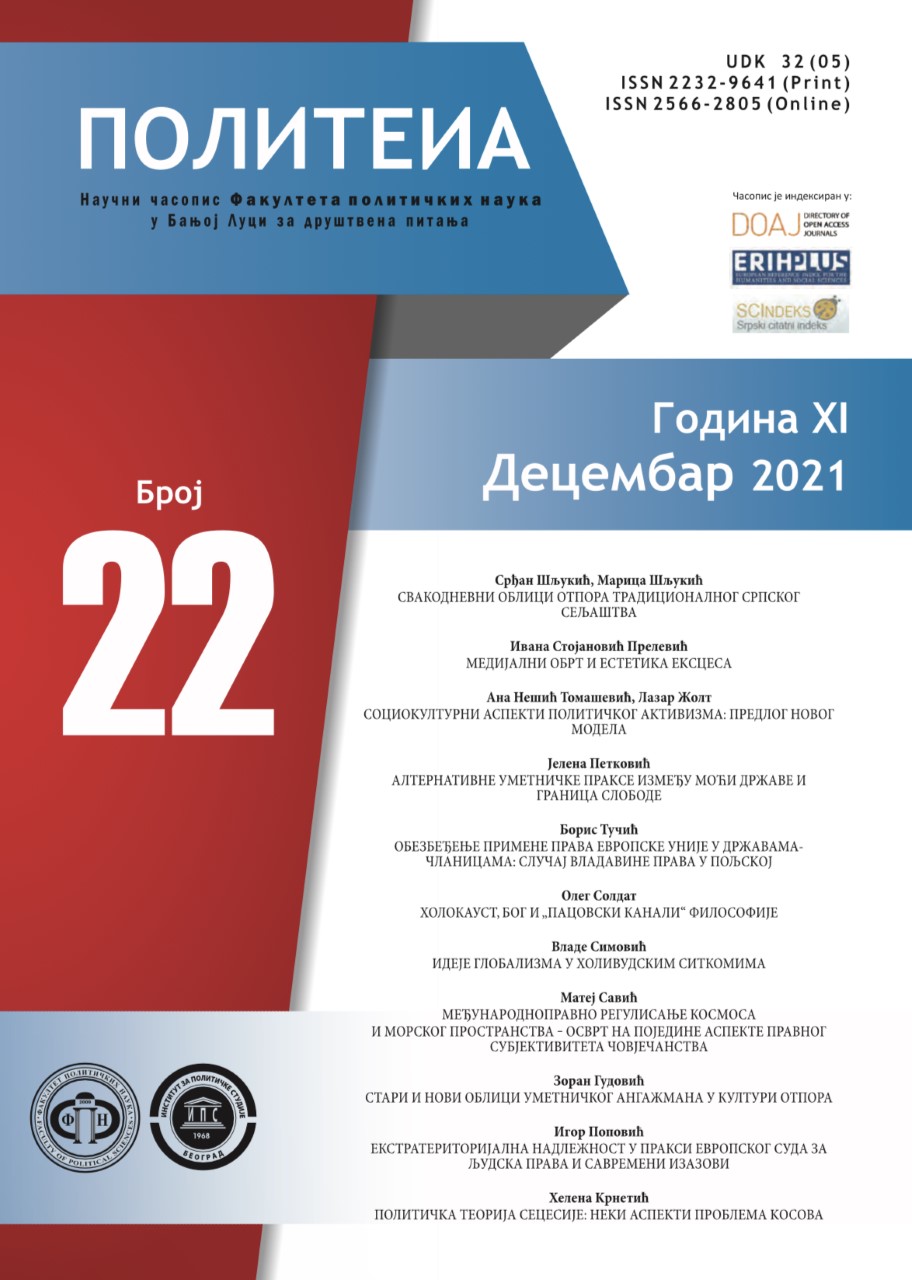ALTERNATIVE ART PRACTICES BETWEEN THE POWER OF THE STATE AND THE BOUNDARIES OF FREEDOM
Abstract
Starting from Theodore Adorno's point of view that the sociability of art is shown through its anti-social character, the paper deals with a sociological analysis of alternative artistic practices and their social reach and boundaries. Associated with a very specific social context, with a clearly established deviation not only from the mainstream of the official, elite art (artistic formalism) but also from the dominant culture and prevailing social values, alternative artistic practices are considered in the context of critical cultural counter-public, which is positioned between the formal and the symbolic powers of the state, on the one hand, and the personal / creative and social freedom of the artist and recipients, on the other hand. In the first part of the paper, we are presented with a general review of the transformations as regards the spheres of artistic creation, reception, and evaluation, which started establishing themselves within Western societies as of the beginning of 20th century, as well as with questioning their most important social functions. Following the existing research and using secondary data sources, the paper continues with an analysis of the underground music scene and lifestyles of young people in Western societies, as well as of those that emerged under the influence of the spread of Western popular culture and art in authoritarian regimes of some Muslim countries in the Middle East, North Africa, and Southeast Asia. Although still sporadic, rather marginalized and regime-controlled, these alternative artistic practices contribute to trans-cultural communication and creative and value synergy, gradually undermining rigid social frameworks and belief systems within different societies (Western and Arab-Islamic) but also between them.
References
Adorno, T. V. (1979). Estetička teorija. Beograd: Nolit.
Adler, A. (1979). Superiority and Social Interest. New York: W. W. Norton & Company.
Aslan, R. (2008). Rock the Mullahs: Can heavy metal music help transform the Middle East? Slate. Posećeno 20. 7. 2021. URL: https://slate.com/culture/2008/07/mark-levine-s-heavy-metal-islam.html.
Becker, H. (2009). Svjetovi umjetnosti. Zagreb: Jasenski i Turk.
Benjamin, W. (1974). Eseji. Beograd: Nolit.
Božilović, N. (2009). Izvan glavnog toka: Sociologija muzičkih potkultura. Niš: NKC.
Božilović, N. (2006). Kič kultura. Niš: IP Zograf, Biblioteka EST/ETIKA.
Božilović, N. (2016). Ogledi o popularnom. Niš: Filozofski fakultet.
Božilović, N. (2017). Preobražaji umetnosti i novi teorijski diskursi. Godišnjak Fakulteta za kulturu i medije, IX (9): 271‒296.
DiMaggio, P. (1987). Classification in art. American Sociological Review, 52(4): 440–455.
Dragićević Šešić, M. (2012). Umetnost i alternativa. Drugo dopunjeno izdanje. Beograd: FDU/Clio.
Dragićević Šešić, M. (2018). Umetnost i kultura otpora. Beograd: Institut za pozorište, film, radio i televiziju, Fakultet dramskih umetnosti: Clio.
Fisk, Dž. (2001). Popularna kultura. Beograd: Clio.
Fraser N. (1990). Rethinking the Public Sphere: A Contribution to the Critique of Actually Existing Democracy. Social Text, no. 25/26: 56‒80.
Griswold, W. (2004). Cultures and Societies in a Changing World. Second edition. Thousand Oaks, CA: Pine Forge Press.
Hebdidž, D. (1980). Potkultura – značenje stila. Beograd: Rad.
Jay Reedy, W. (1986). Art for Society's Sake. Louis de Bonald's Sociology of Aesthetics and the Theocratic Ideology. Proceedings of the American Philosophical Society, 130(1): 101‒129.
Kluge A., & Negt O. (2016). Public Sphere and Experience. London: Verso.
LeVine, М. (2008a). Heavy Metal Islam: Rock, Resistance, and the Struggle for the Soul of Islam. New York: Three Rivers Press.
LeVine, M. (2008b). How heavy metal is working its way into Islam. NPR. Posećeno 22. 7. 2021. URL: https://www.npr.org/templates/story/story.php?storyId=92421152.
Majewska, E. (2019). Art as counterpublics? Modes of resistance in contemporary culture. Przegląd Kulturoznawczy, 3(41): 271‒286.
Mojsi, D. (2012). Geopolitika emocija. Kako kulture straha, poniženja i nade utiču na oblikovanje sveta. Beograd: Clio.
Official site of Iranian Rock band O-HUM. Posećeno 15. 7. 2021, URL:
http://www.o-hum.com/
Peterson, R. A., & Kern, R. M. (1996). Changing Highbrow Taste: From Snob to Omnivore. American Sociological Review, 61(5): 900–907.
Petković, J. (2020) Savremeno društvo i kulturne promene. Niš: Filozofski fakultet.
Prnjat, B. (2006). Uvod u kulturnu politiku. Beograd: Stylos.
Schmutz, V. (2009). The Classification and Consecration of Popular Music: Critical Discourse and Cultural Hierarchy. Rotterdam: ERMeCC, Erasmus Research Centre for Media, Communication and Culture.
Sen-Žan-Polen, K. (1999). Kontrakultura: Sjedinjene Američke Države, šezdesete godine: rađanje novih utopija. Beograd: Clio.
Van Nieuwkerk, K., LeVine, M. & Stokes, M. (ed.) (2016). Islam and Popular Culture. Austin: University of Texas Press.
Warner, M. (2002). Publics and Counterpublics. London: The MIT Press, Cambridge.
Weintraub, A. (ed.) (2011). Islam and Popular Culture in Indonesia and Malaysia (Media, Culture and Social Change in Asia Series). London and New York: Routledge.
- Autori zadržavaju autorska prava i pružaju časopisu pravo prvog objavljivanja rada i licenciraju ga "Creative Commons Attribution licencom" koja omogućava drugima da dijele rad, uz uslov navođenja autorstva i izvornog objavljivanja u ovom časopisu.
- Autori mogu izraditi zasebne, ugovorne aranžmane za neekskluzivnu distribuciju članka objavljenog u časopisu (npr. postavljanje u institucionalni repozitorijum ili objavljivanje u knjizi), uz navođenje da je članak izvorno objavljen u ovom časopisu.
- Autorima je dozvoljeno i podstiču se da postave objavljeni članak onlajn (npr. u institucionalni repozitorijum ili na svoju internet stranicu) prije ili tokom postupka prijave rukopisa, s obzirom da takav postupak može voditi produktivnoj razmjeni ideja i ranijoj i većoj citiranosti objavljenog članka (Vidi Efekti otvorenog pristupa).

